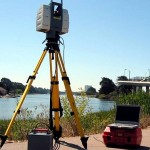3D laser scanning revolutionizes construction site accident investigation and evidence collection
In early October 2012, several construction workers were killed or injured when the Miami Dade College parking garage collapsed like a pancake, trapping a then-unknown number of workers inside (See http://tinyurl.com/9956xae). Some survived, but some did not.
Post-accident site investigation
Since this tragic loss of life, injury, and property damage, lawyers have no doubt already begun what will be expensive and lengthy litigation. The owner, architect, engineer, contractor, subcontractors, construction workers and their families will all play a part.
The evidence may be sifted and sorted for years before any judges or juries hear about what happened on that fateful day.
Ideally, each party would have ample opportunity to investigate the site, take measurements, and form opinions as to what happened. However, this was not an option in Miami.
Workers needed to be freed. The structure’s potential for further collapse endangered all those around it. The owner had a dangerous pile of rubble where a new parking garage was supposed to stand. Certainly, nobody wanted to preserve site conditions for any length of time.
So, how can evidence of existing site conditions be preserved forever? 3D laser scanners were dispatched to the site immediately.
From onsite scan to a 3D model on your computer
Similar to traditional surveying, 3D laser scanners are set-up on tripods and use light to precisely measure their surroundings. But whereas traditional land surveying instruments take only one measurement at a time and need a reflector to return the light, 3D laser scanners take millions of measurements of everything that they can “see” within 300 feet.
This data is collected in a matter of minutes and the instrument can be set up as many times as necessary to see the entire site. Technicians then convert this raw information into a 3D model.
Lawyers and their experts can use this model to return to the day of the accident at any time. They can pan and zoom around the model to find any desired vantage point. Any angle or distance can be measured and re-measured.
Collecting quality evidence
After any given construction accident, investigators take photographs, make measurements and sketches, and interview witnesses. However, even the most seasoned investigator can miss critical details due to time constraints, site access, or simple knowledge of the facts.
Once the site is cleaned up or altered in any way, the evidence is spoiled. However, 3D laser scanning allows investigators to return to the site at any time to retrieve missed or forgotten details.
Additionally, the evidentiary quality of 3D laser scanning data far outweighs traditionally collected evidence. Photographs provide only a single 2D perspective and each detail must be specifically targeted. Manual measurements are subject to observational and recording error. Witnesses certainly cannot permanently remember every visible detail, especially in the wake of a tragedy. 3D laser scanning overcomes all of these limitations.
Full access to the site is often limited, for example, from the danger of additional collapse and loose rubble around the parking garage in Miami. This problem is also overcome with 3D laser scanning, as it uses light to measure from a distance. Anything that can be seen can be scanned and recorded for later review.
Using the model at trial
3D laser scans are not new to the courtroom and readily pass muster under evidentiary challenges. Foundation for entering a 3D laser scan on the record can be laid by a professional land surveyor, but courts nationally have allowed scans based on the testimony of laymen who were simply certified to use the equipment.
At trial, 3D laser scans provide unparalleled demonstrative exhibits. Judges and juries will no longer need to travel to visit a site.
As noted by Lt. Warren Hamlin of the Knox County Tennessee Police Department, “It’s almost like taking the jury right to the crime scene. We can show pictures all day long, but when you’ve got a panoramic view that shows exactly how it looked and where everything was, that’s a much better depiction than a photograph. … So, if a guy says, ‘I was standing in that corner,’ you could create a viewpoint exactly where his head would be and look around the model and tell whether, yes, he could see that, or, no, he’s lying.”
###
David Headrick has over 14 years of experience in the surveying, engineering and legal industries, both as a project manager for LandAir Surveying and as a lawyer in private practice. He has represented numerous land surveyors, designers, architects, contractors and other industry professionals throughout his career. Today, David serves as an executive and project manager for LandAir, focused on developing and managing the company’s 3D laser scanning department. Contact him at dheadrick@lasurveying.com.



Leave a Reply
Want to join the discussion?Feel free to contribute!